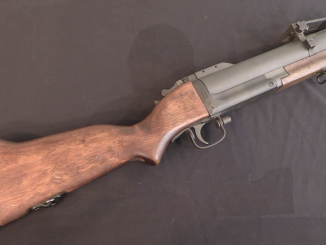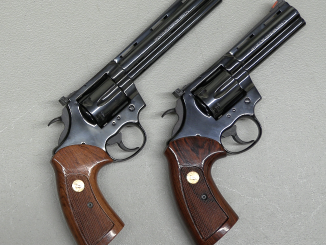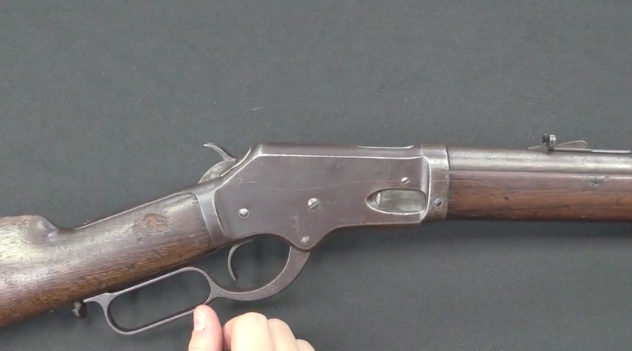The Phillips & Rodgers M47 Medusa is a mechanically very interesting firearm; a revolver that can chamber basically any cartridge with a 9mm bullet diameter and an overall length no longer than a .357 Magnum. This is made possible because a revolver does not have the headspace requirements of a semiautomatic handgun, and the barrel doesn’t know one type of bullet form another, so long as they are not larger than the bore diameter.
What makes it difficult, is finding a way to hold a variety of different cartridges properly in position for reliable firing and extraction. Jonathan Phillips solved this problem with his 1995 patent for the extractor mechanism that is the fundamental heart of the Medusa revolver. It uses long flexible fingers which snap into the extractor grooves on rimless cartridges or can be depressed down away from the cases of rimmed cartridges. These fingers allow proper indexing of virtually any cartridge that will physically fit. They are, however, also the weak point of the gun, as they are pretty much the only fragile component, and since the company quickly went out of business, replacements are completely unavailable.
In my shooting, I used .357 Magnum, .38 S&W, .380 Automatic, 9x20mm Browning Long, 9×19 Parabellum, 9mm Largo, 7.62mm Tokarev , and .32ACP. The last two obviously did not engage the rifleing as they are substantially smaller than the bore, but the fire safely regardless. The most significant question, of course, is how many people would actually have a need for such a system, beyond simply thinking it is cool (and if the multicaliber capability makes up for the finicky loading, extraction, and accuracy).
For a more detailed look at the history of the Medusa, I recommend this article by AirborneCombatEngineer.




“chamber basically any cartridge with a 9mm bullet diameter and an overall length no longer than a .357 Magnum”
This instantly reminded me about one weapon described earlier, Dyer International Caliber Rifle!
https://www.forgottenweapons.com/dyer-multi-caliber-rifle/
“how many people would actually have a need for such a system”
Well, in fact it might be perfect tool for tooling some law system, which beyond requiring permit for weapon, say caliber of fire-arm must be given.
“Tooling” or “fooling” a silly caliber limitation? Sounds like hunters in Weimar Republic Germany using rifles chambered in 8×60 S to get around the “no military caliber weapons permitted” clause of the Versailles Treaty! Speaking of issues with munitions laws, I wonder if 6.5×50 SR Arisaka and 7.7×58 Arisaka violate the Hague Convention considering that both rounds tend to tumble and splinter upon penetrating a victim. Even worse, the anti-aircraft sights on the Type 99 Rifle aren’t very silly in hindsight if you imagine an entire REGIMENT of soldiers firing 7.7×58 HE rounds at a single slow-moving-low-flying biplane. Yes, 7.7×58 Arisaka was made in 5 variants: regular ball, armor-piercing steel, white-phosphorus incendiary, high-explosive, and glowing tracer. I would NOT wish to imagine the results of a human victim hit by a platoon’s volley of explosive bullets (without airplane or truck on the receiving end to make the incoming shots legal). I could be totally wrong.
“This is made possible because a revolver does not have the headspace requirements of a semiautomatic handgun, and the barrel doesn’t know one type of bullet form another, so long as they are not larger than the bore diameter.”
As most revolvers use rimmed cartridge case length and overall length has not meaning, as long as it fit (is not too long) and pressure is not too high (here might be danger, IIRC some late 19th century revolvers for .38 Long Colt will allow .357 Magnum cartridge to go inside, but ability to withstand firing high-pressure cartridge is doubtful at least).
However some revolvers were designed for rimless cartridge (see for example S&W Model 1917) and thus fixing cartridge must be solved in another way that in “normal” revolver (S&W Model 1917 has chambers cut in way that allow head-spacing: case mouth)
Ruger makes 9mm revolver
https://www.all4shooters.com/en/Shooting/pistols/Ruger-LCR-9mm-Luger-lightweight-compact-revolver/
I was also of that impression that Alfa (CR) does, but after looking at their page came out empty. It’s not there any more.
See also Korth Sky Marshal:
http://www.luckygunner.com/lounge/first-look-korth-sky-marshal-9mm-revolver/
revolver designed from scratch for 9×19 Parabellum cartridge
“Nonexistent Apocalypse”
Existent or not, it seems to be useful marketing trick.
Of course the .38 S&W, .38 short and long Colt will all chamber in any .38 Spl or .357 magnum revolver. And Ruger used to offer their Single Six .357 with a spare cylinder chambered for 9mm Luger. I’m sure that a spare cylinder for any .357 could be modified to accept 9mm rimless ammo using half or full moon clips. BTW: The .32 ACP has enough rim to chamber and fire in break-top H&R .32 revolvers.
“.32 ACP has enough rim to chamber and fire in break-top H&R .32 revolvers.”
.32 Auto (7,65 mm Browning) belong to group of cartridge known as semi-rimmed cartridge (or to be more exact cartridges with semi-rimmed cases). Such solution allowed head-spacing on rim, as well was more “box-magazine-friendly” that “truly” rimmed cartridge.
Other semi-rimmed cartridge designed for Browning automatic pistols are: .25 Auto (6,35 mm Browning), 9×20 mm SR Browning Long (used in Husqvarna m/1907 automatic pistol), .38 ACP and derived from it .38 Super.
Talking of enough rim to do the job, a friend of mine was sold a Browning 1910 in 32 but the first shot sounded strange and the fired case was badly bulged. The pistol had a 380 barrel instead of the 32. The extractor probably gripped the cartridge enough to allow firing.
The seller quickly exchanged the barrel with a proper one.
In fact .380 Auto (9×17 Browning) was designed to allow easy conversion .32 Auto .380 Auto, according to:
http://unblinkingeye.com/Guns/1910FN/1910fn.html
John Moses Browning had asked “UMC” Thomas of the Union Metallic Cartridge Company to design the .380 ACP in 1907 because Colt wanted a larger, heavier bullet for the 1903 Colt Pocket “Hammerless”. Browning specified that the case length for the new cartridge must be identical to that of the .32 ACP. The idea was that the only modification necessary for the gun to use the new cartridge would be a new barrel and magazine.
In fact, it is possible to have one universal magazine for .32 Auto and .380 Auto (cf. Ortgies automatic pistol)
I guess Phil’s friend must’ve had the world’s largest stockpile of .32 ACP..
A 357 revolver with a second cylinder in 9 para makes more sense, with clips (like Taurus) or without (like Charter Arms).
This gun negates the ease of use of a DA revolver. It is too tricky to operate!
I have heard that firing 9x17mm in a 9x18mm Makarov will damage the barrel, as the high pressure gas blowing by the bullet will erode the barrel (due to 9mm Makarov being actually a bit bigger than 9mm). Could this also be a problem with firing smaller calibre bullets in this revolver?
I don’t know, but gun barrels with chrome-lined bores would resist corrosion. Or are we talking about friction?
The problem is supposedly high velocity, high temperature gas will blow by the bullet acting like a cutting torch. It may not damage the barrel with one shot, but supposedly with repeated use it will.
There exist wildcat cartridge creating method called fire-forming.
If I am not mistaken it allows (but does not require) firing cartridge with too small bullet.
How it does impact barrel used I don’t know.
Mg
Then vp70 barrel would be in loads of problems. As it has deeper grooves for purpose of gas “blowby”. So, you heard a myth
Makarov’s bullet is 9.27mm
https://en.wikipedia.org/wiki/9%C3%9718mm_Makarov.
It would not pass thru this contraption.
But I do not see how 9mm Browning would damage Mak’s barrel, maybe in long term as you say. Then I’d question why someone buys PM while does not want to buy proper ammo.
There was a time here in the U.S. when 9 x 18mm Mak pocket pistols like the FEG R-61 and PA-63 Walther clones were a lot cheaper than .380 ACP pistols of comparable types. But most 9 x 18 ammunition was either corrosive-primed Chinese or PriviPartizan non-corrosive; the Chinese was easy to find and cheap, the P anything but.
So a lot of people just used inexpensive, non-corrosive U.S. generic .380 in the 9 x 18s. The main result was poor accuracy due to the bullets tending to “skate” down the rifling, and occasional smokestack jams due to the recoil springs being balanced for the greater recoil energy of the 9 x 18 rounds.
I used 9 x 18 exclusively in such pistols, and found that they gave very good accuracy and reliability and had terminal effects not much less than 9 x 19mm, roughly in the range of .38 Special. I concluded that I’d rather not be shot with a 9 x 18.
As far as multi-caliber capability goes, I once verified that .38 ACP (and thus .38 Super Auto) and 9 x 19mm would both chamber correctly in a .38 S&W chambered revolver; to be exact, both a Webley MK IV (Commercial) and a Smith & Wesson Victory Model, with no “alterations” to either revolver. However, in view of the pressure differential between those loads and the .38 S&W /0.380 in revolver cartridges, I wasn’t a big enough fool to try to fire them. I simply note that it can be done, as a caveat to others to make sure that they don’t get such cartridges “mixed in” with .38 S&W rounds, as the results could be both surprising and very dangerous.
cheers
eon
Revolvers and their loadings can get tricky; I never aspired to own one. What I wished to have (now is out of reach in our market) is Czech version of Makarov http://cz-usa.com/product/cz-83-9-mm-browning-satin-nickel-cal-380-auto/
They were made in 9×18 (as CZ82) and in .32ACP/.380ACP (as CZ83). With barrel length under legal limit they are now “prohibited” in Canada. Apparently great guns according to their owners.
I don’t know which barrel length is ok from your point of view, but I want to point MP-444 Багира as modern 9×18 automatic pistol:
http://www.gundata.ru/pistolet_mr_444_bagira.htm
in 9×18 version it has capacity 15, mass without cartridges is 760 g (Makarov automatic pistol: 730 g)
@Daweo
Information I picked up from net:
http://www.rcmp-grc.gc.ca/cfp-pcaf/fs-fd/prohibited-prohibe-eng.htm
Basically, it is 105mm unless pistol was owned prior to existing legal statue (so called grandfathered). I happen to own 7.65mm CZ70 which I acquired shortly after ‘turn-around’ and following dissolution of state security apparatus; that was declared “prohibited” couple of years after. Although I do hold permit for ‘restricted’ firearms and “prohibited” category was dropped, I am out of luck with obtaining CZ83.
The pistol you are showing looks modern with desirable features, unfortunately picture is not very good quality.
@Denny:
Additional photos and photo of partial disassembly:
http://russianguns.ru/?p=2324
Unfortunately barrel length is 101 mm, which is less than 105 mm
According to an article published several years ago in “Cibles” magazine, the carbine version of Medusa was capable to give decent accuracy to .380 ACP when they shot a target 80m away.
Being less tapered than 9 para, 380 has a better chance of aligning itself. And its lower pressure could also be a factor.
It seems than Karl was no given his medication today…
Probably your best intro yet!
This reminds me of the time I was at the range and Googled if you could fire 7.62×39 from a 3-Line Mosin M1930 because I was just sick of paying for 54R… Let me say that I was grateful I used Google before I had to use a hospital lol.
“Non-existent apocalypse”? Preparations by definition are for events that are not yet existent. The headline makes as little sense as grousing, “Why do I need to buy health insurance? I feel fine!”